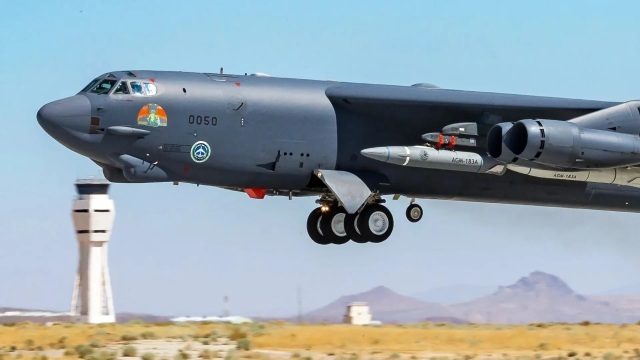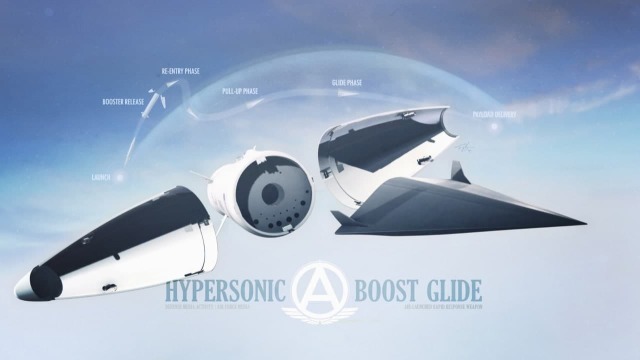The US Air Force reported that on May 14, 2022, a successful flight test of the promising American air-based hypersonic missile AGM-183A Air-Launched Rapid Response Weapon (ARRW) was carried out for the first time. During the test, an experimental rocket over the Point Mugu naval missile range on the Pacific coast of the United States successfully separated from the carrier-a Boeing B-52H Stratofortress strategic bomber and, after launching a solid-fuel accelerator, flew, reaching a set speed of M > 5, although it was not equipped with a payload.

Two experimental non-throwable samples of a promising American Lockheed Martin AGM-183A ARRW hypersonic missile (Air Launched Rapid Response Weapon) on the external suspension of a strategic bomber of the US Air Force Boeing B-52H (US Air Force number 60-0050) during a test flight from Edwards Air Base (California), 08.08.2020 (c) Matt Williams / US Air Force
Prior to that, during 2021, three attempts at the ARRW test launch ended without result - in two cases (April 5 and December 15), the rocket did not separate from the carrier at all, and in another case ( July 28 ), the accelerator did not work. In all cases of launch attempts, as in the test on May 14, 2022, a Boeing B-52H Stratofortress bomber from the 419th Flight Test Squadron of the US Air Force from Edwards Air Base was used as a carrier.
Structurally, the ARRW is a solid-fuel air-launched missile with a warhead in the form of a detachable hypersonic combat unit with a Tactical Boost Glide (TBG) rocket engine, which has been created for some time under the auspices of the Defense Advanced Research Agency (DARPA) of the US Department of Defense. The B-52N and B-1B strategic bombers should be equipped with the missile as a matter of priority, while it was reported that both non-nuclear and nuclear versions are being created. The B-52N aircraft will be capable of four ARRW missiles on an external suspension - two on each pylon.
Presumably, the first aerodynamic tests of the TBG combat unit were conducted in March 2019. From June 2019 to May 2021, the US Air Force conducted seven aerodynamic tests (without resetting) of the AGM-183A ARRW on the B-52N aircraft.
The first flight test of the ARRW rocket was planned first for the middle, then for the end of 2020, but as a result, the first (unsuccessful) launch attempt was made on April 5, 2021. And only now will the first successful test of the rocket be made.
The initial phase of R&D on the ARRW was carried out by Lockheed Martin Corporation under a contract worth $ 480 million issued to the US Air Force in August 2018, work on which was to be completed by December 2021. In December 2019, the US Department of Defense awarded Lockheed Martin a new contract for the full-scale development, testing and preparation for mass production of the ARRW missile, totaling $ 988.832 million. The work was supposed to be carried out very quickly and be completed by December 31, 2022, but it is already obvious that this deadline will not be met. Earlier, it was also reported that the work on the TBG combat unit was about a year behind schedule. However, the first launch of the complete ARRW prototype is now officially still expected before the end of 2022.
In June 2020, the US Air Force planned to purchase eight prototypes of the ARRW missile for flight tests (four for testing and four spare ones), with flight tests in fiscal years 2021 and 2022 and with the beginning of the missile's entry into service (meaning the transfer of four spare prototype missiles for this) with the achievement of initial operational readiness status (IOC) from the beginning of the fiscal year 2023 (that is, from October 1, 2022 calendar year).
However, in March 2022, when approving the US defense budget for fiscal year 2022, the US Congress more than halved funding for the ARRW program. After the 2021 fin. More than $ 300 million was spent on ARRW this year, the US Air Force requested fin for 2022. a year of $161 million for the purchase of the first 12 production ARRW missiles. However, in the approved budget, Congress allocated only $80 million and directed all these allocated funds only to the ARRW R&D program to ensure further additional tests of the rocket. Budget request of the US Air Force for the program for 2023 fin. The year also amounts to only $114.98 million to complete R&D, including the purchase of one prototype rocket. This makes the timing of the start of serial production and entry into service of the ARRW uncertain.
According to the statements of representatives of the US Air Force, the ARRW missile should have a maximum firing range of about 1600 km and a combat unit speed between M = 6.5 and M = 8.

Image of the use of a promising American hypersonic missile Lockheed Martin AGM-183A ARRW (Air Launched Rapid Response Weapon) (c) Airman Magazine
